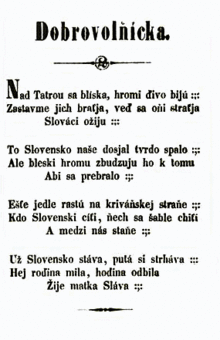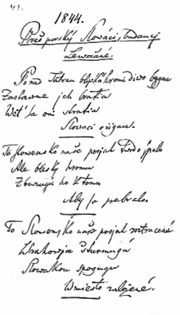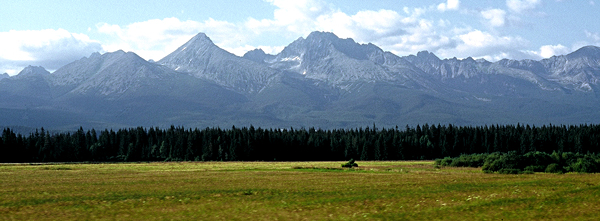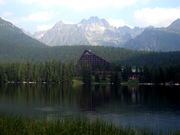Nad Tatrou sa blýska
| English: Lightning Over the Tatras | |
|---|---|
 The first printed version of Nad Tatrou sa blýska. |
|
| National anthem of | |
| Lyrics | Janko Matúška, 1844 |
| Music | folk tune |
| Adopted | 13 December 1918 14 March 1939 1 January 1993 |
| Music sample | |
|
Slovak anthem (Instrumental)
|
|
Nad Tatrou sa blýska (English: Lightning Over the Tatras) is the national anthem of Slovakia. The origins of the anthem are in the Central European activism of the 19th century. Its main themes are a storm over the Tatra mountains that symbolized danger to the Slovaks, and a desire for a resolution of the threat. It used to be particularly popular during the 1848-1849 insurgencies.
During the days of the Czechoslovakia, the anthem was played in many Slovak towns at 12:00 noon. This tradition ceased to exist after the two nations split. Nad Tatrou sa blýska is now performed mainly at special events, including sporting events.
Contents |
Origin
Circumstances

23-year-old Janko Matúška wrote the lyrics of this anthem in January-February 1844. The tune came from the folk song Kopala studienku ("She Dug a Well") suggested to him by his fellow student Jozef Podhradský[1] (1823–1915), a future religious and Pan-Slavic activist, and gymnasial teacher.[2] Shortly afterwards, Matúška and about two dozen other students left their prestigious Bratislava Lutheran lyceum (preparatory high school and college) in protest over the removal of Ľudovít Štúr from his teaching position by the Lutheran Church under pressure from the authorities. Slovakia was part of the Kingdom of Hungary within the Austrian Empire then, and the officials objected to his Slovak nationalism.
"Lightning Over the Tatras" was written during the weeks when the students were agitated about the repeated denials of their and others' appeals to the school board to reverse Štúr's dismissal. About a dozen of the defecting students transferred to the Levoča Lutheran gymnasium.[3] When one of the students, the 18-year old budding journalist and writer Viliam Pauliny-Tóth (1826–1877), wrote down the oldest known record of the poem in his school notebook in 1844, he gave it the title of Prešporský Slováci, budaucj Lewočané ("Bratislava Slovaks, Future Levočians"), which reflected the motivation of its origin.[4]
The journey from Bratislava to Levoča took the students past the High Tatras, Slovakia's and the then Kingdom of Hungary's highest, imposing, and symbolic mountain range. A storm above the mountains is a key theme in the poem.
Versions
No authorized version of Matúška's lyrics has been preserved and its early records remained without attribution.[5] He stopped publishing after 1849 and later became clerk of the district court.[6] The song became popular during the Slovak Volunteer campaigns of 1848-1849.[7] Its text was copied and recopied in hand before it appeared in print in 1851 (unattributed, as Dobrovolňícka – "Volunteer Song"),[8] which gave rise to some variation, namely concerning the phrase zastavme ich ("let's stop them")[9] or zastavme sa ("let's pause").[10] A review of the extant copies and related literature inferred that Matúška's original was most likely to have contained "let's stop them." Among other documents, it occurred both in its oldest preserved handwritten record from 1844 and in its first printed version from 1851.[11] The legislated Slovak national anthem uses this version, the other phrase was used before 1993.

National anthem
On 13 Dec. 1918, only the first stanza of Janko Matúška's lyrics became one half of the two-part bilingual Czechoslovak anthem composed of the first stanza from a Czech operetta tune, Kde domov můj ("Where Is My Home?"), and the first stanza of Matúška's song, each sung in its respective language and both played in that sequence with their respective tunes.[12] The songs reflected the two nations' concerns in the 19th century[13] when they were confronted with the already fervent national-ethnic activism of the Hungarians and the Germans, their fellow ethnic groups in the Habsburg Monarchy.

When Czechoslovakia fell apart into the Czech Republic and Slovak Republic in 1993, the second stanza was added to the first and the result legislated as Slovakia's national anthem.[14][15] The competing national song Hej, Slováci was a version of the international pan-Slavic movement's traditional anthem, Hey, Slavs.
The reference in Nad Tatrou sa blýska to the Tatras has a parallel in the interpretations of Slovakia's coat of arms that was defined during the period when Matúška wrote the lyrics. The Slovak coat of arms is a slight variant of a prominent part of the Coat of arms of Hungary, where it is considered to symbolize the three principal mountain ranges of the pre-1918 Kingdom of Hungary: Mátra, Fatra, and the Tatras. Slovakia was part of the Kingdom of Hungary until 1918. The doublecross in the coat of arms represented these lands from early 9th centure, when Cyril and Methodius came to Great Moravia. They brought this symbol with them from Byzantine Empire. Later Hungarian king Béla IV. has taken the sign and put it into official coat of arms of Hungarian kingdom as a sign of "Northern Hungary", today Slovakia. Although today only the Tatras and Fatra belong to the Republic, and the other one is in Hungary. A more popular explanation is that the three peaks are symbolic of the Tatras. Some say, too, that they represent the mountain group of Vysoká in the High Tatras.
Lyrics
A close reading and notes
| Lightning Over the Tatras |
|
| Nad Tatrou*1 sa blýska, | There's lightning over the Tatras,*1 |
| hromy divo bijú. | thunderclaps wildly beat. |
| Zastavme ich, bratia, | Let us stop them, brothers, |
| veď sa ony stratia, | They'll just disappear, |
| Slováci ožijú. | the Slovaks will revive. |
| To Slovensko naše | That Slovakia of ours |
| posiaľ tvrdo spalo. | has been fast asleep so far. |
| Ale blesky hromu | But the thunder's lightning |
| vzbudzujú ho k tomu, | is rousing it |
| aby sa prebralo.*2 | to come awake.*2 |
| Only the above stanzas have been legislated as the anthem. |
|
| Ešte jedle*4 rastú | Firs*4 are still growing |
| na krivánskej*6 strane.*5 | in the direction of*5 Kriváň.*6 |
| Kto jak Slovák cíti, | Who feels like a Slovak, |
| nech sa šable chytí | let him hold a sabre |
| a medzi nás stane. | and stand among us. |
| Už Slovensko vstáva | Slovakia is rising, |
| putá si strháva. | tears off its shackles. |
| Hej, rodina milá, | Hey/yes, dear family, |
| hodina odbila, | the hour has struck, |
| žije matka Sláva.*3 | Mother Sláva/Glory*3 is alive. |
- Romantic poets began to employ the Tatras as a symbol of the Slovaks' homeland.
- That is, to join the national-ethnic activism already underway among other peoples of Central Europe in the 19th century.
- The standard meaning of sláva is "glory," or "fame." The figurative meaning, first used by Ján Kollár in the monumental poem The Daughter of Sláva in 1824,[16] is "Goddess/Mother of the Slavs."
- The idiomatic simile "like a fir" (ako jedľa) was applied to men in a variety of positive meanings: "stand tall," "have a handsome figure," "be tall and brawny," etc.
- A less rigorous reading could give "on the slope[s] of Kriváň."
- See the article on Kriváň for the mountain's symbolism.
Poetics
One of the trends shared by many Slovak Romantic poets was frequent versification that imitated the patterns of the local folk songs.[17] The additional impetus for Janko Matúška to embrace the trend in "Lightning Over the Tatras" was that he actually designed it to replace the lyrics of an existing folk song. Among the Romantic-folkloric features in the structure of "Lightning Over the Tatras" are the equal number of syllables per verse, and the consistent a−b−b−a disyllabic rhyming of verses 2-5 in each stanza. Leaving the first verses unrhymed was Matúška's license (a single matching sound, blýska—bratia, did not qualify as a rhyme):
- — Nad Tatrou sa blýska,
- a - hromy divo bijú.
- b - Zastavme ich bratia,
- b - veď sa ony stratia,
- a - Slováci ožijú.
Another traditional arrangement of Matúška's lines gives 4-verse stanzas rhymed a−b−b−a with the first verse made up of 12 syllables split by a mid-pause, and each of the remaining 3 verses made up of 6 syllables:[18]
- a - Nad Tatrou sa blýska, hromy divo bijú.
- b - Zastavme ich bratia,
- b - veď sa ony stratia,
- a - Slováci ožijú.
An English rhyming ditty
Note: The prosody, rhyming patterns, and language of the anonymous ad-hoc piece below contain no attributes of the original, or of the canons of Slovak Romantic poetry.
- Far above the Tatra
- lightning bolts are pounding.
- These bolts we shall banish,
- brothers, they will vanish;
- Slovaks are rebounding.
- Our Slovakia was,
- until now, quiescent.
- But the lightning flashing
- and the thunder crashing
- made it effervescent.
References
- ↑ Brtáň, Rudo (1971). Postavy slovenskej literatúry.
- ↑ Buchta, Vladimír (1983). "Jozef Podhradský - autor prvého pravoslávneho katechizmu pre Čechov a Slovákov". Pravoslavný teologický sborník, (10).
- ↑ Sojková, Zdenka (2005). Knížka o životě Ľudovíta Štúra.
- ↑ Brtáň, Rudo (1971). "Vznik piesne Nad Tatrou sa blýska". Slovenské pohľady.
- ↑ Cornis-Pope, Marcel; John Neubauer (2004). History of the Literary Cultures of East-Central Europe: Junctures and Disjunctures in the 19th and 20th Centuries.
- ↑ Čepan, Oskár (1958). Dejiny slovenskej literatúry.
- ↑ Sloboda, Ján (1971). Slovenská jar: slovenské povstanie 1848-49.
- ↑ Anon. (1851). "Dobrovolňícka". Domová pokladňica.
- ↑ Varsík, Milan (1970). "Spievame správne našu hymnu?". Slovenská literatúra.
- ↑ Vongrej, Pavol (1983). "Výročie nášho romantika". Slovenské pohľady, 1.
- ↑ Brtáň, Rudo (1979). Slovensko-slovanské literárne vzťahy a kontakty.
- ↑ Klofáč, Václav (1918-12-21). "Výnos ministra národní obrany č. 4580, 13. prosince 1918". Osobní věstník ministerstva Národní obrany, 1.
- ↑ Auer, Stefan (2004). Liberal Nationalism in Central Europe.
- ↑ National Council of the Slovak Republic (1992-09-01). "Paragraph 4, Article 9, Chapter 1, Constitution of the Slovak Republic". Law 460/1992, Zbierka zákonov.
- ↑ National Council of the Slovak Republic (1993-02-18). "Section 1, Paragraph 13, Part 18, Law on National Symbols of the Slovak Republic and their Use". Law 63/1993, Zbierka zákonov.
- ↑ Kollár, Ján (1824). Sláwy dcera we třech zpěwjch.
- ↑ Bakoš, Mikuláš (1966). Vývin slovenského verša od školy Štúrovej.
- ↑ Kraus, Cyril (2001). Slovenskí romantici: Poézia.
External links
- Anthem of the Slovak Republic - A page at the official website of the President of Slovakia featuring various audio files of the anthem.
- Slovak National Anthem, sheet music, lyrics
|
||||||||||||||